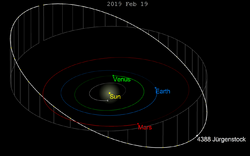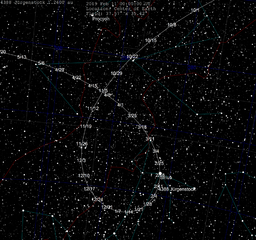Astronomy:4388 Jürgenstock
 Orbital diagram of Jürgenstock with 30 day motion markers | |
| Discovery [1] | |
|---|---|
| Discovered by | Indiana University (Indiana Asteroid Program) |
| Discovery site | Goethe Link Obs. |
| Discovery date | 3 November 1964 |
| Designations | |
| (4388) Jürgenstock | |
| Named after | Jürgen Stock [1] (German-Venezuelan astronomer) |
| 1964 VE · 1982 UA 1999 LG | |
| Minor planet category | main-belt [1][2] · (inner) Phocaea [3][4] |
| Orbital characteristics [2] | |
| Epoch 27 April 2019 (JD 2458600.5) | |
| Uncertainty parameter 0 | |
| Observation arc | 52.90 yr (19,323 d) |
| |{{{apsis}}}|helion}} | 2.9919 AU |
| |{{{apsis}}}|helion}} | 1.6865 AU |
| 2.3392 AU | |
| Eccentricity | 0.2790 |
| Orbital period | 3.58 yr (1,307 d) |
| Mean anomaly | 66.541° |
| Mean motion | 0° 16m 31.8s / day |
| Inclination | 24.588° |
| Longitude of ascending node | 213.83° |
| 194.88° | |
| Earth MOID | 0.7008 AU (273 LD) |
| Physical characteristics | |
| Mean diameter | 4.69±0.75 km[5][6] |
| Rotation period | 2.80956±0.00005 h[7] |
| Geometric albedo | 0.320[5][6] |
| S (assumed)[4] | |
| Absolute magnitude (H) | 13.30[5][6] 13.4[1][2][4] |
4388 Jürgenstock, provisional designation 1964 VE, is a bright Phocaea asteroid from the inner regions of the asteroid belt, approximately 4.7 kilometers (2.9 miles) in diameter. It was discovered on 3 November 1964, by astronomers at Indiana University during the Indiana Asteroid Program at Goethe Link Observatory in Indiana, United States.[1] The assumed S-type asteroid has a short rotation period of 2.8 hours and is rather spherical in shape.[4] It was named for German-Venezuelan astronomer Jürgen Stock.[1] In February 2019, the asteroid occulted the brightest star in the night sky, Sirius.
Orbit and classification
This asteroid orbits the Sun in the inner asteroid belt at a distance of 1.7–3.0 AU once every 3 years and 7 months (1,307 days; semi-major axis of 2.34 AU). Its orbit has an eccentricity of 0.28 and an inclination of 25° with respect to the ecliptic.[2] The body's observation arc begins with its first observation at the Purple Mountain Observatory in Nanking, China, just four nights prior to its official discovery observation at Goethe Link.[1]
Jürgenstock is a member of the Phocaea family (701),[3][4] a large collisional family of nearly 2000 stony asteroids, which is named after 25 Phocaea.[8]:23 As with the Hungarias, many Phocaeans are also Mars-crossers due to their eccentric orbits. However, Jürgenstock just stays shy of the orbit of Mars (1.66 AU) with a relatively small Minimum orbit intersection distance (MOID) of 0.248 AU (37,100,000 km).[1] Moreover, in an alternative HCM-analysis by Milani and Knežević, it has been considered a background asteroid rather than a member of the Phocaea family.[9] On 3 July 2041, Jürgenstock will approach the 200-kilometer sized asteroid 7 Iris at a distance of 6,700,000 km (0.045 AU) with a relative velocity of 5.66 km/s.[2]
Naming
This minor planet was named after German-Venezuelan astronomer Jürgen Stock (born 1923), prominent developer of observatories and director of both the South American Cerro Tololo and the Llano del Hato National Astronomical Observatory in Chile and Venezuela, respectively. The official naming citation was published by the Minor Planet Center on 28 September 1999 (M.P.C. 36126).[10]
Occultation of Sirius
On 19 February 2019, between 5:11 and 5:32 UTC, Jürgenstock occulted the star Sirius in the constellation Canis Major, the brightest star in the night sky. The shadow crossed Southern Argentina, Southern Chile, Central America, and the Caribbean.[11][12] Occultations are typically an excellent method to determine a minor planet's dimension (cross-section) by exactly measuring the duration of the event.
Physical characteristics
Jürgenstock is an assumed S-type asteroid,[4] in agreement with the Phocea family's overall spectral type.[8]:23
Rotation period
In September 2007, a rotational lightcurve of Jürgenstock was obtained from photometric observations by Federico Manzini at the Sozzago Astronomical Station (A12) in Italy. Lightcurve analysis gave a rotation period of 2.80956±0.00005 hours with a brightness variation of 0.11 magnitude, indicative of a spherical rather than elongated shape ({{{1}}}).[7] In July 2014, a similar period determination of 2.810±0.001 hours and an amplitude of 0.10 magnitude was made by Brian Warner at the Palmer Divide Station (U82) in California ({{{1}}}).[13][lower-alpha 1] While Manzini and/or Raoul Behrend suspected it to be an asynchronous binary asteroid with a minor-planet moon in its orbit, Warner did not mention any anomalies in the lightcurve, and the Lightcurve Data Base does not flag the body as a potential binary system.[4][13]
Diameter and albedo
According to the survey carried out by the NEOWISE mission of NASA's Wide-field Infrared Survey Explorer, Jürgenstock measures 4.69 kilometers in diameter and its surface has a relatively high albedo of 0.32.[5][6] The Collaborative Asteroid Lightcurve Link assumes a standard albedo for a Phocaean asteroid of 0.23 and calculates a diameter of 5.79 kilometers based on an absolute magnitude of 13.4.[4]
Notes
- ↑ Lightcurve plot of (4388) Jürgenstock, with a rotation period 2.810±0.001 hours with a brightness amplitude of 0.1±0.01 mag. Quality code is 3-. Summary figures at the Center for Solar System Studies and LCDB.
References
- ↑ 1.0 1.1 1.2 1.3 1.4 1.5 1.6 1.7 "4388 Jurgenstock (1964 VE)". Minor Planet Center. https://www.minorplanetcenter.net/db_search/show_object?object_id=4388.
- ↑ 2.0 2.1 2.2 2.3 2.4 "JPL Small-Body Database Browser: 4388 Jurgenstock (1964 VE)". Jet Propulsion Laboratory. https://ssd.jpl.nasa.gov/sbdb.cgi?sstr=2004388.
- ↑ 3.0 3.1 "Asteroid 4388 Jurgenstock". Small Bodies Data Ferret. https://sbntools.psi.edu/ferret/SimpleSearch/results.action?targetName=4388+Jurgenstock.
- ↑ 4.0 4.1 4.2 4.3 4.4 4.5 4.6 4.7 "LCDB Data for (4388) Jürgenstock". Asteroid Lightcurve Database (LCDB). http://www.minorplanet.info/PHP/generateOneAsteroidInfo.php?AstInfo=4388%7CJürgenstock.
- ↑ 5.0 5.1 5.2 5.3 Nugent, C. R.; Mainzer, A.; Masiero, J.; Bauer, J.; Cutri, R. M.; Grav, T. et al. (December 2015). "NEOWISE Reactivation Mission Year One: Preliminary Asteroid Diameters and Albedos". The Astrophysical Journal 814 (2): 13. doi:10.1088/0004-637X/814/2/117. Bibcode: 2015ApJ...814..117N.
- ↑ 6.0 6.1 6.2 6.3 Mainzer, A. K.; Bauer, J. M.; Cutri, R. M.; Grav, T.; Kramer, E. A.; Masiero, J. R. et al. (June 2016). "NEOWISE Diameters and Albedos V1.0". NASA Planetary Data System: EAR-A-COMPIL-5-NEOWISEDIAM-V1.0. Bibcode: 2016PDSS..247.....M. https://sbnarchive.psi.edu/pds3/non_mission/EAR_A_COMPIL_5_NEOWISEDIAM_V1_0/data/neowise_mainbelt.tab. Retrieved 17 February 2019.
- ↑ 7.0 7.1 Behrend, Raoul. "Asteroids and comets rotation curves – (4388) Jürgenstock". Geneva Observatory. http://obswww.unige.ch/~behrend/page4cou.html#004388.
- ↑ 8.0 8.1 Nesvorný, D.; Broz, M.; Carruba, V. (December 2014). "Identification and Dynamical Properties of Asteroid Families". Asteroids IV. pp. 297–321. doi:10.2458/azu_uapress_9780816532131-ch016. ISBN 9780816532131. Bibcode: 2015aste.book..297N.
- ↑ "(4388) Jurgenstock – Proper elements". Department of Mathematics, University of Pisa. https://newton.spacedys.com/astdys/index.php?pc=1.1.6&n=4388.
- ↑ "MPC/MPO/MPS Archive". Minor Planet Center. https://www.minorplanetcenter.net/iau/ECS/MPCArchive/MPCArchive_TBL.html.
- ↑ "Occultation of Sirius by (4388) Jurgenstock the evening of February 18 2019". Minor Planet Center. http://www.occultationpages.com/rasc/20190219_4388Jurgenstock.html.
- ↑ King, Bob (13 February 2019). "Will Sirius Disappear on February 18th?". Sky & Telescope. https://www.skyandtelescope.com/observing/will-sirius-disappear.
- ↑ 13.0 13.1 Warner, Brian D. (January 2015). "Asteroid Lightcurve Analysis at CS3-Palmer Divide Station: 2014 June-October". The Minor Planet Bulletin 42 (1): 54–60. ISSN 1052-8091. Bibcode: 2015MPBu...42...54W.
External links
- Occultation update for (4388) Jurgenstock, IOTA/IOTA-ES
- Asteroid Lightcurve Database (LCDB), query form (info )
- Dictionary of Minor Planet Names, Google books
- Asteroids and comets rotation curves, CdR – Observatoire de Genève, Raoul Behrend
- Discovery Circumstances: Numbered Minor Planets (1)-(5000) – Minor Planet Center
- 4388 Jürgenstock at AstDyS-2, Asteroids—Dynamic Site
- 4388 Jürgenstock at the JPL Small-Body Database
 |



